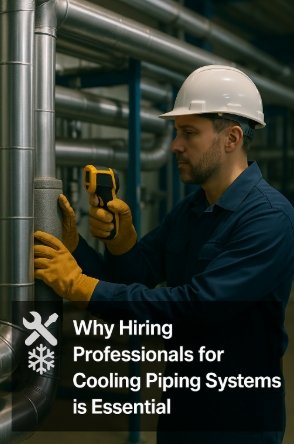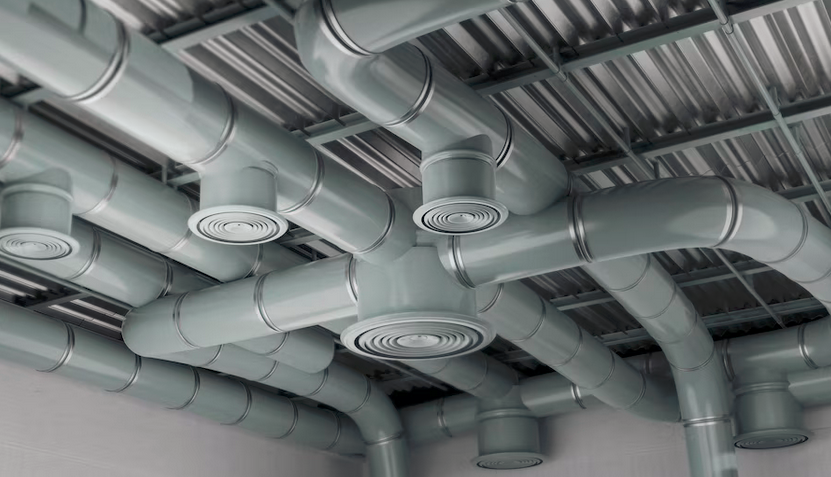Cooling piping systems are critical for maintaining comfortable indoor environments and efficient operations in large commercial, industrial, and residential facilities. These systems help regulate temperatures, manage humidity, and ensure that buildings can operate smoothly, especially when internal heat loads rise from equipment, occupants, or solar exposure.
Professional design, installation, and maintenance of cooling piping systems are key to ensuring system performance, safety, and energy efficiency over the long term.
Why Cooling Piping Systems Are Necessary
Large structures—such as office towers, hospitals, manufacturing plants, and data centers—can accumulate heat quickly. Factors contributing to rising internal temperatures include:
-
Heat from electrical and electronic equipment
-
Body heat from large numbers of occupants
-
Solar gain through windows and roofing
Without a properly functioning cooling system, interior conditions can become uncomfortable, leading to reduced productivity, equipment overheating, and even health risks.
Cooling piping systems play a vital role by transporting chilled water or other cooling mediums throughout the facility. In many systems, a cooling tower extracts unwanted heat from the circulated water and rejects it to the environment, completing the cooling cycle.
Types of Cooling Piping Systems
The design of a cooling system varies depending on the application, but most systems fall into one of these categories:
| System Type | Key Features |
|---|---|
| Compression Refrigeration | Most common for HVAC systems; uses mechanical compression to circulate refrigerant. |
| Evaporative Cooling | Utilizes the natural cooling effect of evaporating water; often paired with cooling towers. |
| Absorption Refrigeration | Uses heat sources (like steam or natural gas) to drive cooling, often for industrial or district systems. |
In industrial settings, chilled water cooling is frequently used, not only for air conditioning but also for process cooling and dehumidification.
Key Components of a Cooling Piping System


A standard cooling piping network integrates several essential parts, all engineered for maximum efficiency and durability:
-
Condenser: Transfers unwanted heat from the refrigerant to a cooling medium (often water).
-
Evaporator: Absorbs heat from the building or process into the chilled fluid.
-
Expansion Valves: Regulate refrigerant flow and pressure within the system.
-
Piping Networks: Connect all components and distribute the chilled fluid.
The design of the evaporators can vary:
-
Shell-and-tube evaporators (common for industrial applications)
-
Brazed plate evaporators (compact, efficient, but initially higher in cost)
-
Direct expansion coils (for air handling units)
Materials commonly used for cooling system components include stainless steel, brass, and cupronickel, chosen for their thermal conductivity, corrosion resistance, and pressure-handling capabilities.
Why Professional Handling of Cooling Systems Is Critical
Cooling piping systems operate under pressure and involve the circulation of refrigerants or large volumes of water. Improper handling can lead to:
-
System failure from leaks, ruptures, or equipment breakdown
-
Safety hazards such as chemical exposure or mechanical damage
-
Property damage from water leaks or catastrophic failure
-
Inefficiency and higher energy bills due to poorly designed or maintained systems
Certified industrial plumbers understand the intricacies of system design, pressure ratings, thermal loads, and safety codes. They ensure that cooling systems are installed and maintained according to:
-
Manufacturer specifications
-
Local mechanical and building codes
-
Environmental and safety standards
Benefits of Professional Maintenance for Cooling Piping Systems
Routine, professional maintenance is crucial for system longevity and efficiency. Key benefits include:
| Benefit | Impact |
|---|---|
| Energy Efficiency | Well-maintained systems use less energy and operate more cost-effectively. |
| Increased System Lifespan | Early detection of wear or issues prevents premature failures. |
| Compliance with Safety Standards | Regular inspections ensure adherence to industrial regulations and codes. |
| Minimized Downtime | Proactive servicing prevents costly breakdowns during critical times. |
Preventive maintenance tasks include checking for leaks, inspecting insulation, verifying system pressures, cleaning heat exchangers, and testing valves and controls.
Cooling piping systems are vital to the safe, comfortable, and efficient operation of modern buildings and industrial facilities.
Proper installation, routine maintenance, and professional oversight are the cornerstones of long-term system reliability and performance.
Whether you are planning a new system installation or maintaining an existing one, always engage experienced, certified professionals to safeguard your investment and ensure optimal system operation.







